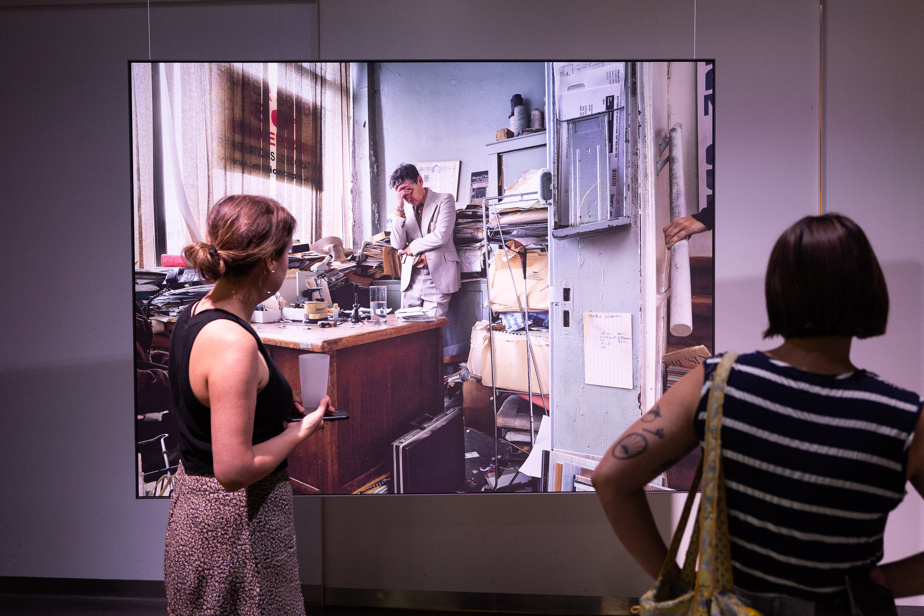What if, instead of photographing a place based on a story you want to tell, it was the place itself that inspired the story? This is the bet made by director and cinematographer André Turpin and artistic director and scenographer Léa Valérie Létourneau in Clusters.
The seven large-format photographs that are exhibited for free at Phi all represent places that inspired these two cinema artisans. The basement of a house, a shop, an office in a museum, a carpet merchant, a warehouse…
Once the location was chosen, André Turpin and Léa Valérie Létourneau imagined a story and a staging, then added actors into the image. The opposite of documentary photography.

PHOTO MARTIN TREMBLAY, THE PRESS
Work signed André Turpin-Léa Valérie Létourneau
Take for example this photo taken in a basement in Sainte-Julie. There are four children there. There is one reading on the stairs, another, a little further back, playing alone in her corner and two others in the foreground. The little girl seems to be singing, while the boy, sitting on the floor, is filling a blender… The floor is covered with popcorn and scattered objects.
“What interests us about these places, even before the staging that we invented, are the places themselves,” André Turpin tells us.
The life that we feel has passed and left on the walls, carpets, ceilings, dust, papers, a smell of nicotine. In the case of this house, it had to be sold after having been inhabited by the same family for generations.
André Turpin
The director ofA crab in the head and ofEndorphin does not hide it, there was also a “desire to immortalize certain places before they disappear”, several businesses having closed their doors in the wake of the pandemic.

PHOTO MARTIN TREMBLAY, THE PRESS
Work signed André Turpin-Léa Valérie Létourneau
In another photo, taken in the same basement but at another end of the room, a musician stands with a trumpet in his hand and makes a note on a sheet of music. In his cluttered office, there is a piano, a television and numerous posters plastered on the wall.
The place, starting point of a story
“Rather than starting with an idea for a scene, an emotion or a character, as we normally do in cinema, we start with a place, and it is this place that inspires us with a staging, characters and a story that we explore in depth,” explains André Turpin. Afterwards, the spectator can also create his own story.”
The title of the exhibition, Clustersrefers to “a mass, an aggregate, an accumulation,” Léa Valérie Létourneau tells us. This is contemporary archaeology, she specifies.
We try to create little planets with these photos, which are a bit like short films that we make.
Lea Valerie Letourneau
André Turpin shares with us his interest in large-format staging photographers like Jeff Wall or the Sanchez brothers. “For me, it’s frozen cinema [still cinema]. But unlike cinema, you can control the image from one end to the other. Cinema is moving, it is the art of time passing, whereas for photography, it is the opposite.
It was Léa Valérie Létourneau who set this project in motion – still ongoing – by taking photos of places she visited for filming.

PHOTO MARTIN TREMBLAY, THE PRESS
André Turpin and Léa Valérie Létourneau
“Normally, when I work on a film, I create locations with a script and to find props I often end up in completely crazy places. I started to photograph them and send them to André. We really worked as a team afterwards to create the staging.”
André Turpin, who had himself started taking pictures of himself lying on the ground (naked) in unusual places (on his Instagram account), quickly seized his friend’s lead. “When I saw the images of places she photographed on Insta, I was fascinated by the amount of detail there was in these places, you really feel that there is a story to tell.”
Details and work on the image
When the two colleagues tell us about a long-term project, we believe them. They spend several weeks taking each photograph, they explain.

PHOTO MARTIN TREMBLAY, THE PRESS
The works of André Turpin and Léa Valérie Létourneau are exhibited at the Phi Centre.
“We can take up to 75 images of the place before reconstructing the photo,” explains André Turpin. “Everything is in focus, we don’t want any blur, there is no depth of field, so we will take 60 photos where we change focus to 1 inch, 2 inches, 5 inches, etc., and then we reconstruct the whole thing so that everything is in focus, with all the details.”
This is one of the first things you notice when looking at these photos, they are faithful to what the human eye captures when entering a room.
André Turpin and Léa Valérie Létourneau now want to enhance the body of ten photographs they have taken together over the past four years. In their spare time, since they are each working on film projects. André Turpin is also the director of photography for Philippe Falardeau’s next film, A thousand secrets, a thousand dangersadapted from the novel by Alain Farah, currently being filmed. A filming that will undoubtedly inspire new locations to stage.
Clusters, until October 20 at the Phi Center
Visit the exhibition page
